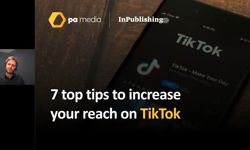
In mid-November, the up-for-sale Johnston Press magically morphed into JPI Media. Presumably there was a price to pay for those that had leant JP the money to buy The Scotsman in 2005 for £160 million, but, apart from some not to be downplayed tweaks to pension arrangements, it seems to be a case of carry-on-as-you-were for JP’s titles and staff, certainly for the time being.
Chief executive David King said: “We will focus on ensuring the group’s titles continue to publish the high-quality journalism we are known for and which has never been more important.”
Now chief executives have to say stuff like that, but it’s important that, as an industry, we really deliver on “high-quality” and not just pay lip service to it.
Roy Greenslade, writing for The Guardian, had some caustic things to say about three JPI Media sites he checked out. With some exceptions, he found a preponderance of promotional fluff and a dearth of meaty local journalism, and the user experience was not pleasant: “all three sites were anything but reader-friendly, with pop-ups, native advertising, promotional features and a lack of search facilities. Similarly, on the homepages, there was a far greater proportion of space devoted to advertising rather than editorial.”
We all need to be clear-eyed about the real quality of what we put out. Self-delusion will only carry us so far.
Of course, resourcing is always a central issue, and here there was some good news at the end of November when Facebook announced its decision to invest £4.5m in supporting local journalism through a scheme called the Community News Project.
The Society of Editors' executive director, Ian Murray, welcomed the move: “It shows a commitment by the digital giant to grassroots journalism, and also just as importantly, to supporting high standards of editorial training.”
It seems churlish to complain about more money for local journalism, but we must be realistic about the long-term outlook.
The BBC’s technology correspondent Rory Cellan-Jones wrote of the Facebook initiative: “That all sounds laudable but what happens to these community reporters at the end of the two-year training period when Facebook stops paying for them? If this kind of ultra-local reporting isn't commercially viable now, why will things have changed?”
The Carole & Amelia Show
Pick any journalism award for 2018 and the chances are that it will have been won by either The Guardian’s Amelia Gentleman, for her exposé of the Windrush scandal, or The Observer’s Carole Cadwalladr, for her uncovering of lots of stuff that Facebook wanted to keep covered.
Amongst the many awards, Carole won two at December’s British Journalism Awards, organised by Press Gazette, including the Investigation of the Year award (jointly with Channel 4 News), while Amelia was named Journalist of the Year.
The judge’s comments are worth noting: “Carole Cadwalladr secured the tell-all interview with whistle-blower Christopher Wylie in defiance of a non-disclosure agreement. Channel 4 News went undercover to reveal how Cambridge Analytica secretly campaigns in elections across the world.”
“Together, this investigation had a huge impact on a matter of massive public interest: the way technology and social media is being deployed to subvert democracy.”
As for Amelia, the judges said: “Amelia’s work exposing the scandalous treatment of Windrush immigrants was astonishing. It set the agenda for weeks and brought down a home secretary (even though the policy came straight from Mrs May). The detail and the case studies were brilliant and everyone followed this story up.”
These were just some of the many awards the two journalists won last year. If they’d been eligible for Pulitzers, no doubt they would have won those too.
Condé Nast to restructure
At the end of November, Condé Nast announced its intention to restructure its global operations into one company. In a statement, the company said: “Over the past year, Condé Nast and Condé Nast International have been working together more closely than ever to refine growth strategies, accelerate innovation and develop the right organisational structures to ensure the company’s success in a rapidly evolving media landscape… To realise the full potential of Condé Nast – for our audiences and our business partners – the time is right for the US and International companies to truly function as one company… Operating as one global company will only help us realise our ambition to deliver the highest quality journalism, experiences and value to our audiences, advertisers and partners.”
All very sensible, although it depends how far they take it. I’m not entirely sure that one size fits all in magazine media, and local nuances are worth preserving, if the product is to avoid becoming completely homogenised. The UK audience is different to the US one which is different to the Australian one.
In the spirit of accentuating the positive, a trait sewn into the DNA of every publisher, missing from the statement was any reference to the financial challenges the company is currently facing.
In January, The Guardian reported that Condé Nast UK made a “pre-tax loss of £13.6m in 2017 – a huge swing from the £6.6m profit recorded the previous year… The company revealed that revenue was down 6.6%, from £121m to £113m.”
The US arm of the company reportedly lost around $120 million in the same period, which just goes to show that even for publishers with gold-plated brands like Vogue, times are tough.
Investing in print
In November, another venerable brand, Esquire, announced its intention to “invest in print” by which it meant… err … reducing its frequency from twelve to six.
Despite appearing less often, the new look title would, we were told, be bigger, be printed on better paper, contain more pages with new sections and contributors and sell at the higher price of £6.
The key to this will be how Hearst repositions the magazine; if it’s the same magazine less often, then they’re really just running down the clock.
But the signs are promising. Editor-in-Chief Alex Bilmes: “In a time of transformational change for media, it is right for Esquire itself to change to ensure we will be the men’s magazine brand of decades to come. The new look Esquire is a tightly focused, proudly niche, highly specialised product… Esquire does not seek to be all things to all men. Instead it seeks to mean a great deal to a specific, extremely influential group of men, and women, – worldly, sophisticated, literate, affluent, urbane – with a genuine interest in living well.”
Apart from the slightly jarring inclusion of “women”, that feels like a solid mission statement for Esquire.
To coincide with the new look magazine (out in February), there will be a refreshed website and more events, including Esquire Evenings, a series of boutique event experiences across the capital, including supper clubs, speaker talks and masterclasses.
Big Issue augmented
It’s busy times at The Big Issue. Fresh from a radical redesign in the autumn, January saw the title dive head first into the exciting world of augmented reality.
Many publishers have dabbled with AR, a scannable image here, a scannable image there, some linking to interesting stuff, some, disappointingly, linking to website homepages, which makes you wonder why they bother.
The Big Issue appears to be taking anything but a tokenist approach. The 7th January edition had AR interactions throughout, including the cover which tells the story of vendor Ann Warke, 53, who turned to The Big Issue when she couldn’t afford to pay her rent due to losing her job. In the future, The Big Issue will be utilising AR on a bi-monthly basis to continue to provide readers with engaging digital content through the pages of the print magazine.
Ben Sullivan, digital editor at The Big Issue, said: “The ‘Tech For Good’ special not only shows the ways in which we’re pushing the boundaries of what print magazines can achieve, but also gives readers enhanced insights into the lives of our vendors, as their stories are brought into video and audio right in front of our readers’ eyes.”
B2B meets B2C
In November, B2B title The Bookseller launched Books in the Media, a book reviews curation and aggregation service. The new consumer facing service pulls together book reviews from a wide variety of sources including national newspapers, consumer monthlies, specialist book journals and radio / TV.
As Nigel Roby, chief executive at The Bookseller explains: “If you happen to be a Daily Mail reader, then you are very unlikely to know that The Guardian has raved about a new novel that might just be spot on for your next purchase. Books in the Media will mean you don’t miss out.”
Well, that’s next year’s Christmas list sorted. The only thing missing was a ‘buy now’ button, but then again, that would probably be commercial suicide for The Bookseller with its readership of independent book shops.
Consequently, the stated aim of the new site is to drive customers to physical bookshops and support independents.
Farewell ShortList
The closure of ShortList magazine in December and the renaming of Shortlist Media as The Stylist Group, caught a lot of people by surprise, not least me.
Gideon Spanier, writing in Campaign, wrote that the move reflected “the brutal state of the print advertising market in the men’s sector.”
Explaining the ascendancy of younger-sister title, Stylist, Spanier said: “Stylist, which launched in 2009, has become more than twice the size of its older sibling by revenue, despite having a lower print circulation of 404,000.”
By embracing and campaigning on important women’s issues, and addressing them in an intelligent and enlightened way, the title has become a dynamic presence in the women’s magazine market. It’s engaging with its audience and the balance sheet is reflecting that.










